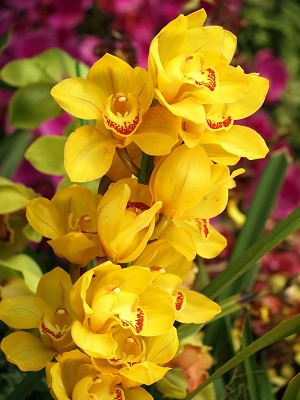
Caring for orchids used to be considered too difficult for many growers and there are some orchids that are rare and difficult to grow. But now, with more than 30,000 species and 120,000 hybrids, there’s an orchid for any level of growing skill. In fact, most orchids do not require any more work than most other house or garden plants. And the rewards of stunning orchid blooms far exceed the joy you will ever experience with any other flower.
Before you begin, do a little research. Do a brief online search or talk to your local orchid lover. These individuals are found in your local garden club or garden center. They are eager to share their orchid growing tips and welcome you into the wonderful world of orchids. Find out what your chosen orchid needs. This will enable you to tweak the general orchid information which we are about to review below, as well as stay away from those varieties that present challenges to any grower, especially beginners.
Start with one of the easiest orchids to grow. Cattleyas, Lady’s Slippers, Cymbidiums, Oncidiums, and Dendrobiums are easy, but my favorite easy orchid is the Phalaenopsis, commonly called the Moth Orchid. White or purple, they are readily available and are also forgiving of minor missteps in care. This orchid awards you with blooms that last up to 3 months.
Light
Place your orchid near a window so that it receives sunlight throughout the day. Avoid the midday sun which can be too harsh. Give your orchid morning and evening sunlight. Placing them in eastern windows of the home is ideal. You can substitute natural sunlight with full spectrum grow lights placed about a foot above the orchid’s blooms to create a total of approximately 12 hours of sunlight per day. This article explains how to properly create orchid light levels in more detail.
Temperature
Orchids thrive in temperatures between 55 and 80 degrees Fahrenheit. Temperatures outside this range will stress most orchids resulting in the loss of its blooms.
Moisture
Water the plant once every seven to ten days, letting your orchid bark or sphagnum dry out before watering. Proper humidity can be easily an inexpensively achieved by keeping the orchid in a water tray, but make sure that the roots do not touch the water in the tray, or it will soak up too much water. Setting your orchid pot atop a deep dish filled with wet pebbles is another easy way to provide the extra humidity that most orchids love.
Food
A great tip to prolonging your orchid bloom is to fertilize the plant before it blooms.
Pruning
Another tip is to carefully prune the orchid while it is blooming. This often results in a second set of flowers without hurting your orchid in any way. This article explains how to give an orchid a haircut.
Related Articles & Free Email Newsletter Subscription
Mokara Orchids Offer Beauty in a Wide Range of Colors
The Top 5 Frequently Asked Questions About Orchid Growing




Comment here